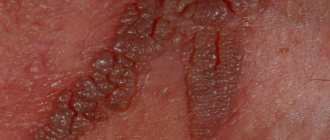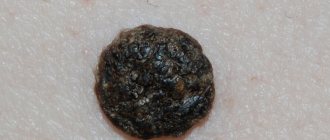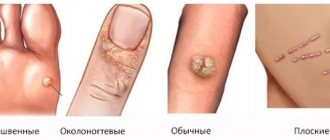Despite the relative safety of most elements, they can cause inconvenience - spoil your appearance, reduce self-esteem, and rub when in contact with clothes and shoes.
Activation of the viral process occurs due to the body’s loss of its protective forces, as a result of which active reproduction of viral elements occurs, and papillomas are formed on the skin. So, why papillomas are dangerous, and what you should especially beware of, we will consider in this material.
What risk factors exist?
The development of the disease does not occur in all people, this is due to the fact that some of their categories belong to the group of risk factors, while others do not belong to it. The factors are:
- diseases of an infectious nature - colds and bacterial processes and phenomena;
- intestinal disorders and diseases;
- inflammatory processes of the lungs;
- lesions in the genital area;
- acute and chronic diseases in the internal organs;
- systemic genetic phenomena of an autoimmune nature;
- problems with normal metabolism;
- the presence of bad habits and poor nutrition;
- elderly age.
As you can see, there are many factors that lead to the formation of these formations.
How to treat human papillomavirus
Unfortunately, there is no cure for the virus itself. Therapy comes down to eliminating symptoms and combating the possible consequences of HPV - precancerous and cancerous conditions.
Warts and papillomas are usually physically removed using different methods. A doctor - a dermatologist, gynecologist, urologist or ENT specialist (if we are talking about growths in the oropharynx area) will help you choose the most effective and safest one.
Precancerous and cancerous conditions can also be cured - the more successfully the earlier the disease is detected. Therefore, WHO recommends that all women over 30 years of age undergo a regular Human Papillomavirus (HPV) Test - during an examination by a gynecologist, take a smear that will help identify precancerous changes in the cervical mucosa. As a rule, it is enough to undergo the procedure once every five years. But if the doctor thinks that in your case it is necessary more often, listen to his opinion.
Screenings are not recommended for men HPV and Men - Fact Sheet. Just remember to consult a doctor if you suddenly notice something unusual - soreness, growth, swelling - in the area of the genitals, anus or oropharynx. Regular examination by a urologist (for men over 40 years old - preferably at least once a year) will reduce the risk of missing something really serious.
Harm of papillomas and risks from their occurrence
In terms of external features, the formation has the appearance of a bulge above the skin surface, and it can be based on a wider base or located in the pedicle area. There are different sizes and colors of such growths; you may encounter formations of pinkish, flesh-colored and other colors.
Although the disease is benign, it is represented by a tumor, which, in the absence of adequate therapy, can lead to cancer-type diseases.
Another danger is that papillomas can migrate within the body, that is, spread throughout the body. Therefore, the presence of papilloma in humans is accompanied by particular danger, because it gives rise to cancer.
The danger of the virus for both sexes
Considering the question of how dangerous the human papillomavirus is, it is worth noting that the danger exists for the fair sex and for the stronger sex.
Female papillomas and their features
This process is classified by type. The most dangerous strains for women's health are considered to be strains of human papilloma in women 16, 18, 31, 33, 35, 45, 52. If they penetrate inside the body, there is every chance of oncological diseases, including erosion of the uterine cervix, dysplasia, and diseases of the anal organs. There is a particular risk for women who smoke. An unpleasant factor in the progression of the disease is that unattractive condylomas may appear on the external genitalia, aggravating their appearance.
Male papillomas and their course
Are papillomas dangerous for men? Of course, yes, however, there are much fewer risks here than for the fair sex. In the male body, the progression of this virus can manifest itself with genital warts, localized in the groin area, for example, in the head of the penis, foreskin, frenulum. These formations can cause a lot of inconvenience and interfere with normal life activities. From this we can conclude that warts must be removed immediately.
Has there been a cure for this disease?
Twenty-first century medicine has come a long way in curing most diseases, and there is a cure for this one too. Patients with human papillomavirus undergo a whole range of different procedures.
First, the wart is removed surgically or using liquid nitrogen. Electric current techniques are also used to remove growths. By removing the result of the virus, we do not get rid of the virus itself. Therefore, additional treatment of the wart site with antiviral ointments and a course of taking antiviral tablets internally are necessary. There is also a method of treatment with folk remedies, but we do not recommend that you practice self-medication. Is it dangerous and is it possible to treat papillomas on your own? Quite likely, although in the vast majority of cases these methods do not work. Despite this, which treatment method you choose is up to you.
Prevention after treatment
Are papillomas dangerous after the course? No, after such procedures you will not have papillomas on your body, but it is advisable to check your body for HPV every couple of years thanks to special tests at the local hospital.
However, self-medication is not necessary here, as this leads to irreversible consequences and will only harm the health or health of a loved one.
Therefore, take good care of your health and be attentive to the health of your family and people dear to you. Do not remain indifferent to even such a trifle as a wart, because, as the conclusion from this article, it can be an indicator of the presence of HPV in the body. HPV can cause cancer, infertility, and unsightly scars for the rest of your life.
Love life, you have only one.
Which strain is the most dangerous?
Science knows about hundreds of strains of this virus. Through samples of biological material, it is possible to determine their type and determine why HPV is dangerous for women or men. So, let's look at the types of HPV for their danger and threat to health.
- Viruses 1, 3, 3, 5 are not oncogenic in nature and do not pose a danger to the human body.
- DNA 6, 11, 42-44 have weak capabilities in terms of provoking the development of oncological processes and phenomena.
- The phenomenon is most dangerous if it is established that its type is 16, 18, 31, 35, 39, 45, 51, 59, 68, because these pathologies are equipped with carcinogenic properties of increased efficiency.
The most malignant formations include 15 genotypes, these are the most dangerous types. However, the interpretation of certain phenomena should be carried out by a strictly experienced and competent specialist, because the numerical indicators of the analyzes do not play as important a role as the qualitative parameters. The highest danger of HPV is observed in viruses of genotype 16, 18. This is about 70% of the total number of strains.
Potential danger of papillomas ↑
Growths can appear on any part of the body and in completely unexpected places. Most often, neoplasms make themselves felt in the genital area and in the mouth of the infected person. Manifestations of HPV are considered benign, but some of them are pathogenic. What is dangerous about papilloma is its complications. Among the complications of the spread of infection are genital cancer.
The papillomavirus has many strains, which, under the influence of negative environmental factors, can provoke the development of ailments in the patient:
- tumors in the esophagus and nasopharynx;
- oncology of the conjunctiva;
- epidermodysplasia verruciformis;
- cancerous lesions of the plane of the foot.
Growths on the epidermis are primarily cosmetic difficulties. More dangerous are neoplasms located on the mucous membranes of the body. Manifestations of HPV located in the larynx area cause hoarseness and respiratory function defects. Papillomas of the paranasal sinuses inevitably lead to damage to surrounding tissues. Growths surrounding the ureter can cause obstruction of the outflow of urine and narrowing of the channels. Neoplasms located on the walls of the bladder often provoke the development of ulcers and bleeding.
A number of features
An experienced specialist will be able to easily decipher the results of the study that was carried out with the available material, prescribe adequate treatment and say whether it is dangerous to remove papillomas in certain cases. This is due to the fact that during the manifestation of such an element in the human body, the viral load indicator is taken into account, which consists in determining the concentration of the virus genotype during the examination period. This indicator is decisive in identifying the degree of threat of the development of cancer diseases and processes. To determine, it is necessary to take into account a number of features that accompany the entire infectious process:
- HPV has a leading place among all infectious processes transmitted through sexual contact;
- if there is a primary infection and immunity is normal, in 75% of situations self-healing can occur without the use of drugs and methods of therapy;
- infection with a virus and the disease itself are not common factors; sometimes the incubation period can reach several months or years, or may never appear at all;
- The insidiousness of the infection lies in its asymptomatic progression until malignant changes appear, and the clinical picture often has similarities with other pathological processes.
So, we have looked at why warts are dangerous; all that remains is to determine the consequences of their presence on the human body. If there is a virus of a carcinogenic nature in the body, you should urgently contact a specialist who can conduct high-quality monitoring of the dynamics of the infectious process and prescribe specific treatment.
The lack of therapeutic intervention creates an increased risk of the formation developing into a malignant tumor.
The onset of the oncological process can be prevented if it is detected and stopped in a timely manner. The modern pharmaceutical field offers progressive removal of papillomas through painless and safe methods, and new vaccines are being developed that have the property of counteracting infection.
Ways the virus enters the body and precautions
Since papillomas are dangerous, you need to know how the virus can enter the human body. HPV settles in small skin cracks, wounds, abrasions and scratches. But it only reaches a healthy person from a sick person.
The most common method of infection is considered to be any form of sex (vaginal, anal, oral). It is in this way that oncogenic strains can be obtained. Moreover, growths can appear on the external and internal genital organs, on the skin around the anus, on the hands and even in the oral cavity.
But besides this, the virus is transmitted:
- To the child, during the passage of the birth canal, from the mother.
- Through general hygiene items (washcloths, towels, razors, scissors).
- In a bathhouse, sauna, or swimming pool, there is also a possibility of infection.
But don't panic. You just need to adhere to the rules of personal hygiene and not have sexual contact with the first partner you meet. Another precaution is vaccination. Teenagers receive three vaccinations, which create lasting immunity to oncogenic HPV.
But such a procedure must be done even before a person begins to be sexually active. Otherwise, the infection has already occurred, and the vaccine will not have the desired effect.
Another danger of the virus is that immediately after infection, papillomas may not appear on the body. For a very long time, it remains dormant in the human body, since the immune system suppresses it. And when the protective functions decrease, the first growths appear.
Reasons for decreased immunity may include:
- Frequent viral diseases.
- Long-term use of medications.
- Wrong lifestyle.
- Monotonous food.
- Chronic gastrointestinal diseases.
- Frequent nervous breakdowns and stressful situations.
- Bad habits.
In what cases are papillomas fraught with danger?
Papilloma can be excessively dangerous in several cases:
- when there is a change in the color of the growth on the skin;
- in case of changes in the size of the formation on the body;
- if the external signs of papilloma change;
- if unpleasant pain occurs at the site of its localization;
- when located in places where there is friction with clothing.
If you are diagnosed with papilloma, you must urgently contact a medical specialist who will develop tactics for the treatment process and help you take action.
What are the symptoms of human papillomavirus
HPV is an insidious thing. Often it does not appear at all. Sometimes signs occur many years later Genital HPV Infection - CDC Fact Sheet after exposure. So it is difficult to determine exactly when the infection entered the body.
The most obvious (but not obligatory) symptom is the appearance of growths on the skin of any part of the body. Papillomas, condylomas, warts - these are all HPV.
Fortunately, most often they go away on their own within a year or two and do not pose a health risk. But if the symptoms of HPV stubbornly do not disappear, and especially if papillomas and warts appear on the genitals or in the mouth and throat area, it is imperative to consult a physician, gynecologist or urologist.
With a prolonged chronic form, HPV can lead to cell changes that eventually turn into malignant ones. On average, it takes 10–20 years from infection to cancer development.
Features of the fight against skin growths
Before treating people and taking measures, a specialist must understand the nature of the disease and the causative factor of its occurrence; for this, PCR diagnostics are carried out, which makes it possible to clarify the specific type of virus and develop a therapeutic regimen.
Most often, a set of antiviral drugs and immune strengthening agents is used. External influence alone is not enough to completely get rid of these formations, since it is necessary to combat the main cause of their occurrence - directly with the virus. Your doctor will help you decide what medications to take against papillomavirus.
Today, conservative medicine and traditional therapeutic methods are often used; traditional methods of treatment are popular among girls and even men, the main thing is to use them correctly.
Since progress does not stand still, hardware therapy methods have proven themselves to be effective, making it possible to quickly and painlessly cure the formation. Traditionally, the methods chosen are determined by the types of virus strains and the personal wishes of the patient. After an external examination and a set of studies, the doctor will decide whether certain methods of intervention can be carried out and will definitely inform the patient about this.
Treatment of pathological growths
Before you start getting rid of papillomas, you need to consult your doctor. Only a specialist will tell how effective this or that treatment regimen is in a particular case.
The fight against HPV begins with the removal of existing papillomas, since they are sources of viral infection and lead to the appearance of new growths. The following methods are used to remove them:
- Surgical excision with a scalpel is a reliable way to remove the viral growth, but subsequently a small scar may remain in its place. Another disadvantage of the procedure is that it is performed under local anesthesia;
Important!
It is impossible to cure papillomatosis, but keeping it dormant throughout your life is quite possible. To do this, you need to regularly take vitamins and take care of your immunity.
- Destruction of neoplasms with liquid nitrogen. One drop of refrigerant leads to freezing and subsequent destruction of the formation along with the root;
- Laser removal is a reliable, painless way to combat HPV symptoms. The beam is directed at the growth, after which it dries up and falls off;
- You can also get rid of papillomas using electric current, chemicals, and medications;
- The last option was the use of alternative medicine. They are based on plants that have cauterizing and antiviral properties, due to which the growth dries out and falls off on its own.
Blackening of papilloma
If the papilloma turns black, then this is a sure sign of the beginning of the development of an infectious process in the body.
Papilloma can turn black in the following cases:
- injury;
- wearing tight underwear, which leads to chafing;
- trying to remove it yourself.
Blackened papilloma
If the papilloma turns black and falls off for no apparent reason, you should immediately consult a doctor.
We suggest that you familiarize yourself with the reasons for the appearance of small papillomas on the body
Common types of papillomas
There are more than 70 types of HPV, which provoke types of papillomas such as:
- Flat - small neoplasms up to 1 cm in diameter, brown in color, slightly raised above the level of the skin.
- Vulgar - have a round shape, appear in groups of 3-4 pieces. rough and dense in structure, can cause itching and pain when touched.
- Plantar - develop on the soles, having a characteristic flattened shape. It causes pain when walking. Often confused with corns and calluses.
- Pointed - look like a cockscomb or cauliflower. Shapeless, soft in structure, but with awkward movement they are easily injured.
- Thread-like (acrochords) - directed upward, looking like threads. They are flesh-colored and painless.
- Papillomas of the bladder and urinary canals impede the natural processes of removing fluid from the body and can provoke cancer of the urinary system.
- Papillomas of the mucous membrane of the mouth, larynx and trachea make breathing and eating difficult, which requires immediate surgical intervention.
Vulgar papillomas, localized on the hands and feet, are typical for children and adolescents. Thread-like, pointed and plantar types are more common in older people.
How to get rid of papillomas at home
At the first signs of papilloma on the skin, you can use alternative medicine methods that demonstrate sustainable positive dynamics of the disease. The warts disappear, and the human body again acquires a presentable, healthy appearance. Productive disposal of papillomas at home is possible after preliminary consultation with your doctor; superficial self-medication is excluded:
- To stop the growth of papilloma, the best way is to rub it with dry laundry soap or celandine juice. Repeat the procedure several times until the unpleasant symptoms completely disappear.
- Prepare castor oil and rub it on papillomas all over the body. It is allowed to carry out the procedure up to three times a day. Alternatively, use garlic pulp, sour apple puree or dandelion juice for viral condyloma.
- Iodine in combination with kerosene is also effective. If you properly smear the papilloma on the palm or foot with such a medicinal composition, then after the first session it dries out, and after the second it completely disappears.
We invite you to read: Causes of acne on the face in women
Types of neoplasms ↑
In professional practice, dermatologists encounter the five most common forms of neoplasms on patients’ bodies:
- simple;
- plantar;
- thread-like;
- flat;
- pointed.
To answer the question of whether papillomas are dangerous, you need to go to the hospital and undergo an examination. The potential danger of papilloma for the patient depends on the form of the ailment. Simple or vulgar growths can be found on the hands and fingers. Most often they make themselves felt in adolescence and childhood. Neoplasms are considered absolutely safe and can disappear even without special treatment. Simple papillomas look like hard neoplasms. They have a rough surface and range in size from 1 mm to 5 cm. The growths have a tendency to adhere to keratinized epithelial cells.
Plantar warts are often called pincer warts. Many patients confuse pinches on the soles with calluses. In the initial stages, the neoplasm resembles a small shiny bump. Over time, it transforms into a large papilloma, surrounded by a protruding rim. Smaller warts extend from the root of the main growth. Located on the patient’s feet, they cause a lot of discomfort when walking. Since the tongs are in close contact with the shoes, they are often subject to mechanical deformation. This can lead to the degeneration of the growth into a malignant tumor.
In elderly patients, filamentous neoplasms often manifest themselves. Outwardly, they resemble yellowish cones. Warts grow in length and gradually transform into elongated growths. Among the favorite places for their location are the intimate area, neck, armpits and eyelids. Why is filamentous papilloma dangerous? The tumor is in close contact with items of clothing, so there is a high probability of damage. Warts in the armpits have favorable conditions for spreading as soon as the patient begins to sweat.
Flat warts may appear on the patient’s hands and face. Their main danger is that the growths can contribute to the development of inflammatory processes on the skin. The formation of flat growths is accompanied by severe itching. In color they practically do not differ from the main skin. Papillomas get their name due to their flattened shape. Outwardly, they can resemble a circle, an oval, or even a polygon. In isolated situations, the neoplasm begins to turn red.
Genital warts are found on the surface of the reproductive organs and are considered an extremely dangerous manifestation of the papillomavirus. They can also affect the mouth, cervix and anus. New growths take on a flesh-colored, pink or red color. They are attached to the patient's body thanks to a thin stem and can reach sizes of several centimeters. Often, growths provoke genital cancer, regardless of the patient’s gender.
Nature of localization
Such formation can occur on any part of the human body. Most often, HPV infection is localized in the following areas of the human body:
- genitals;
- throat;
- language;
- eyelid;
- vagina;
- mammary gland (both men and women);
- fingers.
We suggest you familiarize yourself with what is a wen in the mammary gland
In more severe clinical cases, the formation of papillomas is possible even in the area of the bladder and urethra.
Intraductal papilloma of the mammary gland is a tumor that develops in the milk duct. Such pathological changes may be accompanied by unpleasant physiological symptoms:
- redness on the nipple;
- itching and burning;
- when pressed, bleeding and sharp pain may occur;
- green, milky or brown discharge.
Initially, intraductal papilloma of the mammary gland is not regarded as a malignant tumor. But if the pathological process is not detected and treated in a timely manner, intraductal papilloma can develop into a malignant formation. The latter can cause the development of breast cancer.
Externally, papilloma on the nipple looks like a small process of the nipple type. The color of this formation is strikingly different from the epidermis.
The etiological factors that contribute to the development of intraductal papilloma of the mammary gland are the following:
- abortions;
- metabolic disorders, resulting in obesity;
- ovarian dysfunction;
- infectious diseases;
- severely weakened immunity.
Most often, intraductal papilloma occurs in women who have bad habits, have not given birth, and often change sexual partners.
Intraductal papilloma of the mammary gland
Treatment of intraductal papilloma on the human body is carried out only surgically. Papilloma on the nipple is regarded as a precancerous condition, so drug treatment alone is inappropriate here. This operation does not leave any significant scars on the body. There is no prevention as such in this case. But the disease can be detected in a timely manner if it is regularly examined by a mammologist and gynecologist.
Papilloma in the throat
Papilloma in the throat is a pathological formation on the mucous membrane of the throat. Most often, papillomas in the throat do not show any symptoms. The patient may only occasionally feel some discomfort.
As papillomas grow in the throat, an infected person may complain of the following symptoms:
- difficulty swallowing (even liquids);
- a sore throat;
- sensation of a foreign body in the throat.
As the source of infection develops, there are more papillomas in the throat. As a result, the voice may change, breathing becomes shallow and rapid.
There may be several reasons for the formation of such papillomas in the body:
- chronic illnesses;
- childhood infectious diseases;
- abuse of nicotine, alcohol, and other drugs;
- unprotected sexual intercourse, frequent change of sexual partners.
Also, the appearance of papillomas in the throat is possible due to frequent visits to public places - saunas, baths, swimming pools. It is also worth noting that weakened immunity is the first and most common cause of the development of a focus of infection.
Comprehensive treatment brings good results in the treatment of papillomas in the throat. Initially, all papillomas in the mouth are removed. After this, the doctor prescribes medication. There is no targeted cure for papillomas. Complex treatment involves taking antiviral drugs and vitamins (to strengthen the immune system).
Removal of papillomas in the mouth is mandatory. Even one such formation can cause the development of infection throughout the body. Please note that it is impossible to remove papillomas in the mouth at home. This should only be done by a specialist.
Cervical papilloma is warty growths with jagged edges (sometimes they look like smooth processes) on the lining of the uterus. Such a pathological process is regarded as an oncogenic factor. If treatment is not started in a timely manner, cervical cancer may develop.
The reasons for the development of this type of disease in the female body can be the following factors:
- sexual contact with a man who is a carrier of HPV infection;
- weak immunity;
- lack of personal hygiene;
- alcohol and drug abuse.
Infection can occur in public places such as baths, swimming pools, saunas. Also, if the mother has HPV, the child may be born already infected.
Symptoms of cervical papilloma are:
- enlarged lymph nodes on the body;
- burning in the area of the external genitalia;
- green, light brown or milky discharge (sometimes with a strong unpleasant odor).
Treatment of cervical papilloma involves local therapy (removal of warty processes) and medication.
Multiple condylomas of the cervix
It is worth noting that papillomas on the genitals can form not only in women, but also in men. The only difference is that papillomas in men are much less often diagnosed as oncogenic. In most cases, it is enough to remove the formation and take a course of antiviral drugs. But treatment at home, without a doctor’s recommendation, is contraindicated.
Papilloma on the tongue
Papilloma on the tongue looks like a papillary formation up to 2 centimeters. Infection can occur in two ways - from close contact with an infected person or through household appliances.
Papillomas on the tongue can form even in children. This is explained by the fact that young children often put toys and foreign objects in their mouths. At the same time, their immune system is still weakened.
Treatment for this type of HPV is the same as for other cases. Initially, papillomas on the tongue are removed to prevent the spread of infection. Afterwards, a course of antiviral drugs is prescribed.
Removal of papillomas on the tongue should only be carried out by a competent specialist. Treatment at home is unacceptable. The same applies to the case if a papilloma forms on the eyelid. Such formations consist not only of the epidermis, but also of blood vessels. Therefore, a tear can cause severe bleeding.
Treatment cannot be observed
Clinical manifestations of HPV can be in the form of genital warts (they are also called anogenital warts), which can be either single or multiple, located on the mucous membrane of the vestibule of the vagina, labia and glans penis - it is difficult not to notice. But oncological diseases (mainly cancer of the cervix, vulva, vagina and penis) are often detected very late.
In the vast majority of cases, cervical cancer (CC) is provoked by HPV serotypes 16 and 18. WHO studies have shown that the risk increases many times with an active sexual life with frequent changes of sexual partners. The direct relationship between HPV and cancer has prompted many developed countries to conduct screening (systematic mass studies for the early detection of HPV infection). According to the professor of the Scientific Center for Obstetrics, Gynecology and Perinatology. Academician V.I. Kulakov Inna Apolikhina , most women with advanced stages of cervical cancer have not visited a gynecologist for more than 10 years.
Article on the topic
Papilloma: sun and heat lovers are at risk “In order to find them and reach them, we need a state screening program with the formation of a unified cytological database,” Professor Apolikhina is sure. – From the point of view of insurance medicine, screening is cost-effective. After all, treatment of invasive cervical cancer costs an average of 1 million rubles, and diagnosis and treatment of a precancerous process on the cervix costs approximately 15–20 thousand rubles.”
During screening, a cytological examination of cervical smears (PAP - smeartest) is mandatory. According to the expert, the scope of screening may vary depending on the woman’s age (PAP smear only or PAP smear + HPV test).
Unfortunately, there is no specific therapy for HPV: it is impossible to eliminate the virus from the body with the help of medications. For now, doctors can only remove genital warts and, if necessary, perform surgery on the cervix. Their volume varies depending on the stage of the process. Gentle techniques have been developed in which a woman who has undergone surgery for cervical cancer at an early stage can become a mother.
What to do if HPV is detected in the body during the study, but there are no clinical manifestations? Specialists of the Scientific Center for Obstetrics, Gynecology and Perinatology named after. Academician V.I. Kulakov developed patient management tactics depending on the results of the study. If PCR (polymerase chain reaction) reveals the presence of HPV of low oncogenic risk, then in any case it is necessary to re-test a year later. If there are genital warts, remove them. Cryo-, electro- and laser coagulation, a radio wave knife, and also chemical coagulation are used. Despite the fact that there are a number of drugs that allow you to remove warts yourself, you should never do this if they are localized in the anogenital area: with unprofessional manipulation, a side effect may be the spread of the virus to adjacent tissues damaged during the removal of the affected ones.
Article on the topic
Human papillomavirus: you cannot get rid of it, but you can cure it. Treatment with immunomodulators and Indinol Forto (selective estrogen receptor modulator) is also indicated. If there are no clinical manifestations, then you should take 400 mg per day for 3 months, if there are, then at the same dose for six months.
If tests show the presence of highly oncogenic HPV types, then the tactics change. In the absence of clinical manifestations, it is necessary to do a cytological examination of cervical smears twice a year, take immunomodulators and Indinol Forto for six months. If there are clinical manifestations on the cervix, pathological areas are removed, Promisan is used (a drug with multiple antitumor activity, effective in the early stages of the process) and the progress of treatment is monitored at least once every three months.
There is no consensus in global medical practice regarding the use of immunomodulators and antiviral agents. “From the perspective of evidence-based medicine, only the local use of immunomodulators is proven,” says Inna Apolikhina. – Among them we can highlight Imiquimod cream. Although Russia has accumulated a lot of material on the use of systemic immunomodulators, we often recommend them for recurrent processes.” But in any case, the doctor’s main tool for now is careful observation. If the virus has been detected, you cannot relax.
Symptoms
The disease passes in a latent form, but in some cases it can cause the appearance of papillomas on the genitals. Genital condylomas most often affect women between 15 and 30 years of age.
Is papilloma dangerous for women? Yes. The main danger associated with HPV is the high likelihood of developing cervical cancer. This pathology shortens a woman’s life by an average of 26 years. The risk of developing cancer increases if the virus remains in a woman’s body for more than one year.
Cervical cancer can be latent until the final stages, when the effectiveness of therapy is significantly lower.
As for men, HPV is much less dangerous for them than for women. Often a man is a passive carrier. The likelihood of the virus transforming into cancer is much lower.
Many people are wondering whether papillomas on the penis are dangerous. The presence of HPV in a man’s body can cause the appearance of genital warts on the glans penis, foreskin or frenulum. Such formations should be removed as soon as possible, as they interfere with proper hygiene, as well as sexual activity.
Who is at risk for HPV infection?
The following categories of patients most often encounter this problem:
- People who begin to be sexually active at 15-16 years old, when the immune system is not able to fully fight the virus.
- In the absence of a permanent sexual partner and chaotic sexual relations without barrier contraception.
- People visiting swimming pools, saunas and baths, where the risk of contracting the virus is greatest.
- If there is a person sick with the virus in the family or close circle.
- With weak immunity and lack of support during the off-season.
- If a person has chronic inflammatory processes that weaken the immune system in general.
- In the absence of good nutrition and a healthy lifestyle.
In swimming pools, baths, saunas, the risk of contracting the papilloma virus is greatest.
The risks of developing negative consequences haunt those people who deliberately avoid medical examination. The virus may not indicate its presence in the body for a long time or may appear in places that are inaccessible. Scheduled and unscheduled diagnostics (if there are complaints) will reduce the risk of developing extensive papillomatosis.
Almost all people who have encountered warts are interested in the question of why papillomas occur? In fact, doctors have long given a clear answer to this question: growths on the skin of this type appear in cases where the human papillomavirus enters the body.
Many types of HPV are even transmitted through contact. A person can hold on to a handrail in an entrance or on a bus and already encounter warts.
You can also become infected with the papilloma virus through small lesions or wounds on the skin. This problem can also arise if personal hygiene rules are not followed.
The virus is also transmitted through household contact. Sharing the same utensils and personal hygiene products with an infected person can cause infection.
If the child’s mother was already infected with HPV during pregnancy, then with a probability of 84% this infection will also be present in the body of her child. The papilloma virus can penetrate the placental barrier. Papillomavirus during pregnancy
It is worth noting that HPV may not take root in the body, provided that the person has very good immunity. Since this is rare in the modern world, more than 90% of people are infected with papillomavirus.











